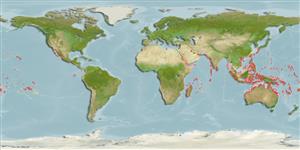Common names from other countries
>
Gobiiformes (Gobies) >
Gobiidae (Gobies) > Gobiinae
Etymology: Bathygobius: Greek, bathys = deep + Latin, gobius = gudgeon (Ref. 45335).
More on author: Bleeker.
Environment: milieu / climate zone / depth range / distribution range
Ecologia
marinhas; estuarina associadas(os) a recifes; intervalo de profundidade 0 - 10 m (Ref. 48637), usually 0 - 2 m (Ref. 89972). Tropical; 32°N - 28°S
Indo-Pacific: East Africa to Johnston, Marquesas and Tuamoto islands, north to southern Japan, south to the southern Great Barrier Reef and Rapa Islands; Marianas and Marshall Islands in Micronesia. Misidentified as Bathygobius fuscus in Hawaii (Ref. 7490).
Tamanho / Peso / Idade
Maturity: Lm ? range ? - ? cm
Max length : 12.0 cm TL macho/indeterminado; (Ref. 11344)
Descrição breve
Chaves de identificação | Morfologia | Morfometria
Espinhos dorsais (total) : 7; Raios dorsais moles (total) : 9; Espinhos anais: 1; Raios anais moles: 8. Characterized by mottled brown overall color, with five alternating irregular whitish and brown blotches or saddles dorsally on body; lower half of side with 5-7 rectangular brown blotches; white spots and blotches on cheek and operculum; upper 4-5 pectoral rays branched to base, tips membrane-free; rounded caudal fin; longitudinal scale series 37-38; predorsal scales 10-12, nearly reaching to above rear margin of preopercle; scales absent on cheek and operculum; ctenoid body scales, becoming cycloid on abdomen, breast and nape; depressed head, width greater than depth; depth of body 5.0 in SL (Ref. 90102).
Lives among rubble, in sand pockets, or on reef rock and is abundant on silty intertidal reef flats (Ref. 9360, 58302). Benthic (Ref. 58302). Gut analysis composed of polychaetes, isopods, amphipods, and brachyurans (Ref. 9360, 48637).
Life cycle and mating behavior
Maturities | Reprodução | Spawnings | Egg(s) | Fecundities | Larvas
Myers, R.F., 1991. Micronesian reef fishes. Second Ed. Coral Graphics, Barrigada, Guam. 298 p. (Ref. 1602)
Categoria na Lista Vermelha da IUCN (Ref. 130435)
CITES (Ref. 128078)
Not Evaluated
Ameaça para o homem
Harmless
Utilização humana
Pescarias: espécies comerciais; Aquário: Espécies comerciais
Ferramentas
Relatórios especiais
Descarregue XML
Fontes da internet
Estimates based on models
Preferred temperature (Ref.
115969): 24.7 - 29.3, mean 28.2 (based on 2826 cells).
Phylogenetic diversity index (Ref.
82804): PD
50 = 0.5000 [Uniqueness, from 0.5 = low to 2.0 = high].
Bayesian length-weight: a=0.00708 (0.00333 - 0.01504), b=3.09 (2.92 - 3.26), in cm Total Length, based on LWR estimates for this (Sub)family-body shape (Ref.
93245).
Nível Trófico (Ref.
69278): 3.5 ±0.6 se; based on size and trophs of closest relatives
Resiliência (Ref.
120179): Elevada, tempo mínimo de duplicação da população menor que 15 meses (Preliminary K or Fecundity.).
Fishing Vulnerability (Ref.
59153): Low vulnerability (10 of 100).
